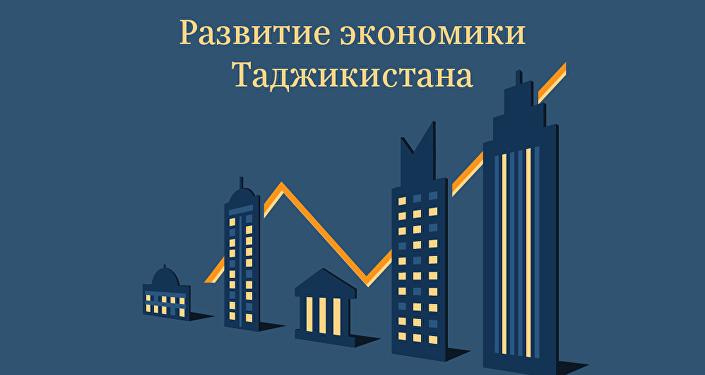Tajikistan’s Economic Development in 2021 Expected to Go Over 7%
Read also

DUSHANBE, 10.02.2021 (NIAT Khovar) – Industry officials note that a significant decline in prices for the country’s export goods on world markets and the devaluation of the national currencies of our main trading partners had a consequential impact on Tajikistan’s economy.
However, an increase in production in industry and agriculture, and growth of foreign trade turnover, including in exports, has contributed to the development of our economy.
According to the Ministry of Economic Development and Trade officials, 142 new industrial enterprises with 2,428 new jobs were created in 2020. The volume of industrial production reached over 30.8 million somoni. The total agricultural production amounted to over 33.6 million somoni, with the growth rate reaching 9.7% and 8.8%, respectively.
The economy has increased by 4.5% in 2020, and the gross domestic product (GDP) reached 82.5 billion somoni.
In a talk, the head of the Main Department for Macroeconomic Analysis, Forecasting and Economic Reforms of the Ministry of Economic Development and Trade Saidmurod Zainiddinzoda noted that under the influence of external factors, the volume of paid services to the population in 2020 decreased by 9.9 %, and the turnover of domestic trade followed a similar trend, decreasing by 6.8 %. Imports decreased by 5.9 %, investments in fixed assets by 4.6 % and passenger transportation declined by 2.5 %.
According to him, there is a tendency towards an increase in GDP growth rates after the first half of 2020. If the GDP growth rate in the first half of 2020 was only 3.5 %, then in general in 2020 it reached 4.5 %, or 944.8 million somoni. The situation in some sectors has also improved compared to the first half of 2020. Particularly, at the end of 2020, the growth rate of industrial production compared with the first half of 2020 increased by 0.5 percentage points, and agricultural production by 0.6 percentage points. In other words, the measures taken by the government to reduce the negative impact of the coronavirus pandemic on the country’s economy proved effective, because if the anti-crisis measures had not been implemented, the country’s economy would have grown by 2.0% instead of 4.5% in 2020.
“The country’s economic growth in 2021 is projected at 7.6%, and it is quite possible to realize this internal potential,” said Zainiddinzoda.
Despite the pandemic, which limited the financial position of the country’s trading partners and the import of goods, foreign trade turnover in 2020 continued to grow.
The head of the Department for Regulation and Development of Foreign Trade of the Ministry of Economic Development and Trade Eraj Abdurahmonov said that the implementation of specific measures to support industrial entrepreneurship, the provision of privileges for the import of raw materials and the production process, and the simplification of trade procedures affected the foreign trade turnover, and by 2020, foreign trade turnover compared to 2019 increased by $ 34.1 million.
According to him, the export of goods compared to 2019 increased by 19.8%, or by $ 232.5 million, and the import of goods compared to the same period last year amounted to $ 198.4 million, which is a decrease of 5.9%.
The share of wheat, vegetable and animal oils, sugar and confectionery products in the structure of food imports is higher. In particular, in 2020, wheat imports amounted to 999,200 tonnes for a total of $ 243.2 million, vegetable oil imports reached 102,000 tonnes for a total of $ 89.4 million.
In connection with the increase in the cost of essential products, including flour and butter, which took place in 2020, Abdurahmonov noted that in order to protect the consumer market and ensure the country’s food security, the export of goods and products during the spread of the pandemic were restricted, and with protective measures taken, this resulted in the rise in prices for products in importing countries.
In particular, the average prices for imported wheat rose by $ 39, flour by $ 12, and vegetable oils by $ 46 per tonne compared to the average price for 2019.
In this regard, the cost of some of the country’s export products changed in 2020. The average export prices for primary aluminum decreased by $ 222, cotton fiber declined by $ 126, and minerals went down by $ 111 per tonne compared to 2019.
Abdurahim Abdukahhor











 Joint Statement by the Ministries of Foreign Affairs of the Republic of Tajikistan and the Kingdom of Bahrain on the Occasion of the 30th Anniversary of the Establishment of Diplomatic Relations
Joint Statement by the Ministries of Foreign Affairs of the Republic of Tajikistan and the Kingdom of Bahrain on the Occasion of the 30th Anniversary of the Establishment of Diplomatic Relations The Political School of the Leader of the Nation in the Context of the Activities of the People’s Democratic Party of Tajikistan
The Political School of the Leader of the Nation in the Context of the Activities of the People’s Democratic Party of Tajikistan Tajikistan, EBRD sign loan and grant agreements for energy loss reduction project
Tajikistan, EBRD sign loan and grant agreements for energy loss reduction project Modern Parliamentarism and the Role of the Asian Forum of Parliamentarians on Population and Development: From Experience Sharing to Practice-Oriented Policy Worldwide
Modern Parliamentarism and the Role of the Asian Forum of Parliamentarians on Population and Development: From Experience Sharing to Practice-Oriented Policy Worldwide Tajikistan to Welcome Global Investors at “Dushanbe Invest-2025” Forum
Tajikistan to Welcome Global Investors at “Dushanbe Invest-2025” Forum Tajikistan’s Transport Minister Highlights Importance of Joint Projects in Seoul
Tajikistan’s Transport Minister Highlights Importance of Joint Projects in Seoul Tajik–Swiss Business Forum Held in Dushanbe
Tajik–Swiss Business Forum Held in Dushanbe Direct Air Connectivity Established Between Xi’an and Dushanbe
Direct Air Connectivity Established Between Xi’an and Dushanbe Tajik Delegation Participates in 69th IAEA General Conference
Tajik Delegation Participates in 69th IAEA General Conference Swiss Cooperation Office Ready to Develop New Initiatives in Tajikistan
Swiss Cooperation Office Ready to Develop New Initiatives in Tajikistan Tajikistan attracts USD213 million from international financial organizations
Tajikistan attracts USD213 million from international financial organizations Tajikistan Chamber of Commerce and Industry Opens Representative Office in Beijing
Tajikistan Chamber of Commerce and Industry Opens Representative Office in Beijing














